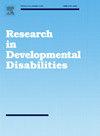Child and family characteristics associated with verbal communication difficulties in adolescents with autism and other developmental disabilities
IF 2.9
2区 医学
Q1 EDUCATION, SPECIAL
引用次数: 0
Abstract
Background
Verbal communication difficulties are associated with a range of adolescent and adult outcomes in individuals with autism spectrum disorder (ASD). Yet there is limited information about contextual factors associated with verbal communication difficulties beyond early childhood, and how youth with ASD compare to youth with other developmental disabilities (DD).
Aims
The current study examined verbal communication difficulties among adolescents with ASD and other DD, and child and family characteristics associated with these difficulties in later in life.
Methods and procedures
Children were classified as ASD or other DD between 2 and 5 years old. Caregivers of these same children reported verbal communication difficulties between 12 and 16 years old. Chi square tests examined group differences in adolescent verbal communication difficulties; Poisson regression examined child and family characteristics associated with adolescent verbal communication difficulties.
Outcomes and results
Adolescents with ASD had significantly more verbal communication difficulties (47.4 %) than adolescents with other DD (14.6 %). Factors that predicted verbal communication difficulties in adolescents with ASD and other DD were expressive language abilities and internalizing symptoms in early childhood, having a mother of non-Hispanic Black compared to White race, and having a mother with some college compared to an advanced degree.
Conclusions and implications
Almost half of adolescents with ASD had verbal communication difficulties, which was significantly higher than those with other DD. Early childhood and socio-demographic factors like race, education, and insurance were associated with verbal language outcomes. These factors may be useful in identifying and supporting those most likely to benefit from targeted communication services.
What this paper adds?
Verbal communication difficulties are common among adolescents with autism. Early childhood and socio-demographic characteristics like race and education are associated with these difficulties. These findings could help better identify and support adolescents with communication difficulties.
与患有自闭症和其他发育障碍的青少年语言交流障碍相关的儿童和家庭特征。
背景:言语交流障碍与自闭症谱系障碍(ASD)患者的一系列青春期和成年期结果有关。目的:本研究调查了患有自闭症谱系障碍(ASD)和其他发育障碍(DD)的青少年的语言交流障碍,以及与这些障碍相关的儿童和家庭特征:2至5岁的儿童被归类为自闭症或其他残疾。这些儿童的照顾者报告了他们在 12 至 16 岁期间遇到的语言沟通困难。卡方检验检验了青少年语言交流障碍的群体差异;泊松回归检验了与青少年语言交流障碍相关的儿童和家庭特征:患有自闭症的青少年的言语沟通障碍比例(47.4%)明显高于患有其他障碍的青少年(14.6%)。预测患有自闭症和其他残疾的青少年出现言语交流障碍的因素包括幼儿期的语言表达能力和内化症状、母亲为非西班牙裔黑人而非白人、母亲拥有大专学历而非高等学历:近半数患有自闭症的青少年存在语言交流障碍,这一比例明显高于患有其他障碍的青少年。幼儿期和社会人口因素(如种族、教育和保险)与口头语言的结果有关。这些因素可能有助于识别和支持那些最有可能从有针对性的沟通服务中受益的人。本文有何新意?在患有自闭症的青少年中,言语交流障碍很常见。幼儿期和社会人口特征(如种族和教育程度)与这些困难有关。这些发现有助于更好地识别和支持有沟通障碍的青少年。
本文章由计算机程序翻译,如有差异,请以英文原文为准。
求助全文
约1分钟内获得全文
求助全文
来源期刊

Research in Developmental Disabilities
Multiple-
CiteScore
5.50
自引率
6.50%
发文量
178
期刊介绍:
Research In Developmental Disabilities is aimed at publishing original research of an interdisciplinary nature that has a direct bearing on the remediation of problems associated with developmental disabilities. Manuscripts will be solicited throughout the world. Articles will be primarily empirical studies, although an occasional position paper or review will be accepted. The aim of the journal will be to publish articles on all aspects of research with the developmentally disabled, with any methodologically sound approach being acceptable.
 求助内容:
求助内容: 应助结果提醒方式:
应助结果提醒方式:


